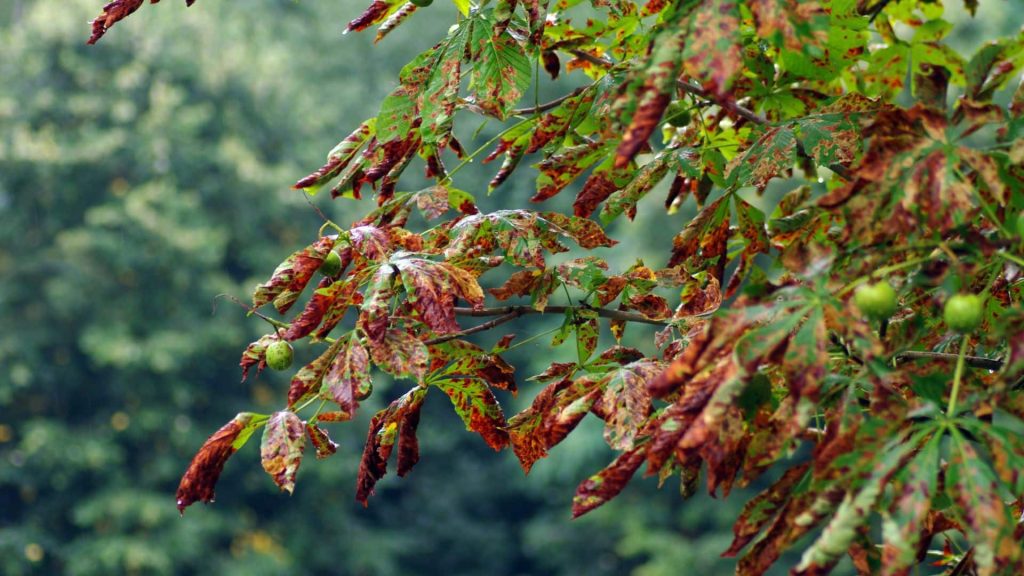When you know how to spot a sick tree in your yard, you’re protecting more than just plants in the picturesque neighborhoods of Billerica and throughout Middlesex County. These aren’t just landscape features, they’re living investments that enhance your property value, provide that perfect cooling shade during those hot Massachusetts summers, and create the charming character that makes our local communities feel like home.
The Hidden Dangers Lurking in Your Yard
You may not realize it, but that seemingly healthy maple or oak in your front yard could be harboring disease or damage that’s invisible to the untrained eye. By the time most homeowners notice something is wrong, the tree might already be beyond saving. Inaction can lead to unexpected removal costs, property damage from falling limbs, or even injury to family members. In Billerica’s weather patterns from heavy winter snow to summer storms, a compromised tree becomes a significant liability.
When you learn to spot a sick tree early, you can take quick action that may save not only the tree but also thousands in potential damage and removal costs. Better yet, by addressing tree health issues promptly, you can protect the beauty and safety of your entire property.
Early Warning Signs: How to Spot a Sick Tree
Trees communicate their distress in various ways. By becoming familiar with these signals, you can intervene before small problems become major issues. Here are key indicators that your tree might need attention:
Unusual Leaf Appearance
Your tree’s foliage can tell you a lot about its overall health. Pay attention to these warning signs:
- Discolored leaves outside of the fall season: Yellowing, browning, or spotted leaves during spring or summer often indicate nutrient deficiencies or fungal infections common in the Middlesex County region.
- Premature leaf drop: If your tree is shedding leaves during Billerica’s growing season when neighbors’ similar trees remain fully foliated, this could signal stress or disease.
- Smaller than normal leaves: Undersized foliage suggests your tree isn’t getting adequate nutrients or water, potentially due to root problems or soil issues particular to our New England terrain.
- Thinning canopy: When sections of your tree have noticeably fewer leaves than others, this pattern often reveals branch dieback or systemic health issues.
The changing of seasons in Billerica provides an excellent opportunity to spot a sick tree through leaf abnormalities. During spring leaf-out, healthy trees should display consistent coloration and leaf development throughout the canopy. Uneven budding or strange leaf formations merit closer inspection.
Trunk and Bark Issues
A tree’s bark is like its skin, it’s changes can indicate serious underlying problems:
- Vertical cracks or seams: Deep splits in the trunk, prevalent after Billerica’s freeze-thaw cycles in late winter, may allow entry for harmful pathogens.
- Missing bark or exposed wood: Areas where bark has fallen away expose your tree to insect infestation and fungal infections prevalent in Massachusetts.
- Fungal growth: Mushrooms or conks growing on or around the base of a tree indicate internal decay that may have been developing for years unseen.
- Oozing sap or fluid: While some seasonal sap flow is normal, excessive or dark-colored oozing often signals bacterial infection or insect activity.
Longtime Billerica residents know that our region’s older homes often feature mature trees that have endured decades of weather extremes. These venerable specimens deserve special scrutiny, as their size and age make them both more valuable and potentially more hazardous if health issues go unaddressed.
Root Concerns
Though largely hidden from view, root problems frequently trigger visible symptoms above ground:
- Soil heaving around the base: If the ground appears raised or cracked near your tree, the root system may be failing, a particular concern in areas of Billerica with clay soils that expand and contract.
- Fungal growth at the base: Mushrooms emerging from the soil around your tree’s trunk often indicate root rot, which compromises stability.
- Construction damage: Recent excavation, driveway installation, or home improvements near trees can sever critical roots, with symptoms appearing months or even years later.
- Sudden leaning: A tree that has recently begun to tilt may have compromised root structure, creating an urgent safety issue, especially in Billerica’s occasionally strong northeasters.
In many Middlesex County neighborhoods, especially newer developments, soil compaction from construction can stress trees for years, making them more susceptible to disease and infestation. Knowing your property’s history can help you spot a sick tree more effectively.
Pest and Disease Indicators
Billerica and surrounding communities face specific threats that warrant vigilance:
- Spotted lanternfly evidence: This invasive pest, increasingly concerning in Massachusetts, leaves distinctive egg masses and honeydew that promote sooty mold growth.
- Emerald ash borer signs: D-shaped exit holes and serpentine galleries under the bark of ash trees indicate this destructive beetle has arrived, requiring immediate professional consultation.
- Gypsy moth damage: Recurring defoliation by these caterpillars, common in Middlesex County, can severely weaken oaks and other hardwoods.
- Cankers and bleeding: Sunken areas on branches or trunks, sometimes oozing fluid, indicate fungal or bacterial infections that may eventually girdle and kill affected areas.
Regular monitoring allows you to spot a sick tree before these issues progress beyond treatment. Many invasive pests have only recently reached our region, making early detection particularly valuable.
Read More: The Most Common Tree Pests in Massachusetts & How to Stop Them
Seasonal Considerations for Tree Health Monitoring
The changing New England seasons offer distinct opportunities to spot a sick tree:
Spring Assessment
As Billerica emerges from winter, healthy trees should show vigorous bud break and consistent leaf development. Spring is an ideal time to spot a sick tree by noting:
- Delayed budding: Trees significantly behind others of the same species may be struggling with root or vascular issues.
- Sparse flowering: Flowering trees like dogwoods and cherries that show reduced blooming may be conserving energy due to health challenges.
The spring growing season in Middlesex County typically reveals which trees have sustained winter damage or entered the year in a weakened state. Early intervention can make the difference between recovery and decline.
Summer Vigilance
During Billerica’s warm months, healthy trees should display full, evenly green canopies. Summer issues to watch for include:
- Premature color change: Leaves turning fall colors in July or August signal serious stress.
- Insect activity: Excessive chewing damage, stippling, or honeydew production indicates pest problems that can quickly escalate.
Massachusetts summers can bring drought stress that compounds existing health issues. A tree already compromised by disease or root damage will often show symptoms first during dry spells, helping you spot a sick tree before its neighbors begin to struggle.
Fall Observations
While autumn naturally brings color change and leaf drop, timing and patterns matter:
- Uneven color change: Sections changing color significantly earlier than the rest may indicate vascular problems in those branches.
- Retained dead leaves: When brown leaves remain attached through winter (especially on oaks), this often signals branch death.
The fall season in Billerica provides a final opportunity before winter to address tree health issues while the ground remains workable and treatments can still be applied.
Winter Examination
With leaves gone, the tree’s structure becomes fully visible, revealing:
- Crossing or rubbing branches: These create wounds that serve as entry points for disease, especially problematic with Billerica’s occasional ice storms.
- Cracks and splits: Winter damage from temperature extremes often appears as vertical separations in the bark.
New England’s dormant season allows for careful structural assessment that might be obscured by foliage during growing months. Professional arborists often prefer winter evaluations to spot a sick tree’s architectural issues.
Why Choose Marquis Tree Service for Your Tree Health Needs
When you spot a sick tree on your Billerica property, your choice of tree care provider can determine whether that tree recovers or requires removal. Marquis Tree Service offers distinct advantages for both residential and commercial property owners:
- Local knowledge and experience: Our team understands the specific diseases, pests, and environmental stressors affecting trees in Middlesex County. This regional expertise allows us to quickly spot a sick tree’s particular challenges and apply appropriate solutions.
- Preventative approach: We believe in addressing problems before they require drastic measures. Our assessment protocols help identify issues early, often saving trees that other services might recommend removing.
- Comprehensive care options: From targeted treatments for specific diseases to structural pruning that promotes long-term health, we offer solutions tailored to each tree’s unique situation.
- Safety prioritization: Our fully insured team uses industry-best practices to protect your property and family during all tree care operations.
- Environmental stewardship: Whenever possible, we implement treatment plans that preserve trees as vital community assets rather than removing them, recognizing their importance to Billerica’s local ecosystem.
Middlesex County homeowners consistently choose Marquis Tree Service because we understand both the technical aspects of tree health and the emotional connection residents feel to their landscape. Our recommendations always balance safety concerns with preservation goals, giving you options rather than ultimatums.
Protecting Your Landscape Investment
The mature trees surrounding many Billerica homes often represent thousands of dollars in property value and decades of growth that cannot be quickly replaced. When you learn to spot a sick tree early and partner with qualified professionals, you protect this investment in multiple ways:
- Safety assurance: Proactive care prevents unexpected failure that could damage your home or harm family members.
- Cost management: Early treatment is invariably less expensive than emergency removal and replacement.
- Environmental benefits maintenance: Your trees provide shade, wildlife habitat, and air quality improvements that benefit the entire Billerica community.
By developing the habit of regularly examining your trees and knowing what warning signs to look for, you become an active steward of your property’s most valuable natural assets. The ability to spot a sick tree before symptoms become severe is a skill that pays dividends for any Massachusetts homeowner.
See More: How Trees Improve Property Value and Curb Appeal
How to Spot a Sick Tree and The Value of Vigilance
Trees enhance our Billerica homes with beauty, shade, and character, but they require attentive care to thrive in our changing New England environment. By learning to spot a sick tree through regular observation and understanding the warning signs of decline, you can take timely action that preserves these important landscape elements.
Don’t wait until it’s too late! Trees may seem sturdy, but disease spreads silently—what you see today might be just the tip of the problem. Ready to protect your green investments? Contact Marquis Tree Service today for your free tree health assessment! Our local Billerica experts will help you spot a sick tree before problems escalate, providing tailored solutions that preserve your landscape’s beauty and value.

